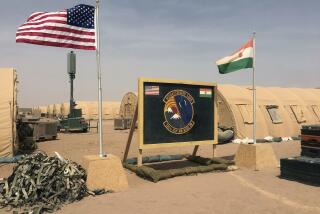U.S. to Withdraw Jets From Philippines : Military: The last fighter planes will leave next year, along with 1,800 personnel. Talks are to resume in Manila on American bases.
- Share via
MANILA — The Pentagon plans to withdraw all fighter aircraft based in the Philippines by September, ending an era at America’s oldest overseas military base, U.S. officials said Wednesday.
Officials said the United States will redeploy 48 F-4 Phantom tactical fighter-bombers now stationed at giant Clark Air Base, as well as more than 1,800 military personnel assigned to them.
Despite previous plans, none of the Vietnam War-era jets will be replaced by more sophisticated F-15 Eagle aircraft, the officials said. The F-15s will go instead to Elmendorf Air Force Base in Alaska.
The move, announced shortly after White House special negotiator Richard L. Armitage arrived for the third round of talks on the future of six U.S. military facilities here, came as a surprise to the Philippine government.
But Foreign Secretary Raul Manglapus said he was pleased that the United States is removing its 3rd Tactical Fighter Wing in line with previous Philippine demands.
“They gave us what we wanted,” Manglapus said late Wednesday. “We’re happy about that.”
Last September, the Philippines served notice that it wants “full sovereign control” of Clark and four smaller communications facilities by the time the present bases lease expires next September. Manila said it also wants joint military use of Clark by January.
A Pentagon official here said the redeployment was “influenced” by the Philippine demands, but more important factors were Air Force budget constraints, worldwide force restructuring and changing security demands.
A statement by the U.S. Embassy cited the high cost of new systems required by the F-15s, a “long-term investment . . . which the U.S. has concluded makes more sense in Alaska, all things considered.”
The statement said the United States is reassuring allies that removal of the two fighter squadrons “in no way diminishes our commitment or ability to meet our responsibilities in the Pacific.”
Clark, about 65 miles north of Manila in central Luzon, has about 8,500 U.S. military personnel. The sprawling base dates back to the U.S. colonial war here at the turn of the century. The first airfield was built in 1919.
In recent years, Clark was the busiest single-runway base in the U.S. Air Force. It has served as a major operations and logistics hub for the western Pacific and Indian Ocean since World War II.
U.S. officials said they hope to continue using Clark for a Military Airlift Command operation and the 44,000-acre Crow Valley bombing and pilot-training range in nearby Capas, Tarlac. They want to leave up to 3,000 troops as well.
Philippine officials have said they hope to transform Clark into a new international airport and cargo facility. Given the country’s current economic crisis, those plans are unlikely to be realized any time soon, however.
The current round of talks, expected to end Friday, will focus on the U.S. proposal for a 10- to 12-year cutback of operations at the other major base here, the Subic Bay Naval Base, a key repair and logistics center for the U.S. 7th Fleet.
More to Read
Sign up for Essential California
The most important California stories and recommendations in your inbox every morning.
You may occasionally receive promotional content from the Los Angeles Times.














